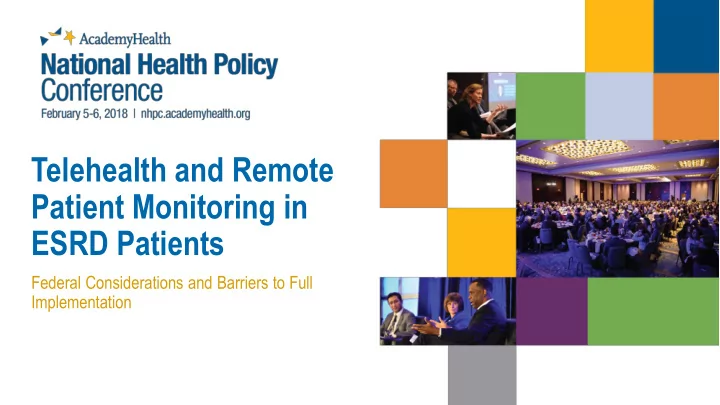

Telehealth and Remote Patient Monitoring in ESRD Patients Federal Considerations and Barriers to Full Implementation
A New Paradigm The 2010 passage of the Patient Protection and Affordable Care Act signaled the Federal government’s intent to change healthcare delivery Greater focus on preventive and maintenance services for chronic diseases Increased use of technology to facilitate care More patient engagement and empowerment for self-care Push towards community and home-based healthcare
Telehealth and RPM in Chronic Disease Telehealth has been utilized to manage patients with varying types of chronic disease including: Stroke Diabetes Dermatology Asthma Cardiovascular Disease Some mental health conditions
ESRD Patients End Stage Renal Disease (ESRD) currently affects over 400,000 patients in the US The majority of these patients participate in the Medicare program The only treatment available is a kidney transplant or renal dialysis, which most patients undergo. The two types of available dialysis modalities include Peritoneal dialysis (PD) & Hemodialysis (ICHD or HHD)
Home Therapy for ESRD Patients Only 10% of patients on dialysis are on home therapy, even though: Many patients prefer to receive health care, including dialysis, at home. Home dialysis offers patients health benefits such as reduced risk of cardiovascular mortality, lower rates of hypertension, and fewer of the physical health impacts of regular dialysis. Patients on home dialysis can be more active in the workforce. It can be a lifeline for patients with limited ability to travel and who live in rural areas far from dialysis facilities. References Available Upon Request
Telehealth, RPM & ESRD Patients Medicare telehealth services are currently covered only if patients are seen at certain designated sites (e.g., certain hospitals and health centers). Providing patients options to access telehealth services from home may incentivize patients to adopt home dialysis as a treatment option. Patients can avoid costly, time-consuming and unnecessary visits to facilities, and stay engaged in the workforce. Increasing telehealth access will encourage access for patients in rural and underserved areas.
Barriers to Telehealth & RPM Use In Home Dialysis Despite the existence of technologies that allow effective monitoring of home dialysis patients, barriers preventing full access to such services exist. Home as originating site Geographic restrictions Lack of economic data Parameters surrounding “meaningful interactions” Patient education
CMS Actions The Centers for Medicare & Medicaid Services (CMS) has also been actively engaged in telehealth issues related to ESRD patient services In 2015, CMS finalized the addition of several CPT codes in support of the addition of monthly capitation payment services for the treatment of ESRD to their telehealth list The Center for Medicare & Medicaid Innovation (CMMI) also supported a pilot exploring use of telemedicine in peritoneal dialysis aimed at improving outcomes of patients and establishing a sustainable telemedicine model for that patient population
Congressional Actions There are several bills that have been introduced in Congress that specifically call out home dialysis as a part of the telehealth environment HR 2550: Medicare Telehealth Parity Action (status: pending in House) HR 3178: Medicare Part B Improvements Act status: passed the House) S 870: Creating High-Quality Results and Outcomes Necessary to Improve Chronic Care/”CHRONIC act” (status: passed the Senate) HR 1130/S 598: Chronic Kidney Disease Improvement in Research and Treatment Act (status: pending in respective houses)
Telehealth Definitions Ongoing discussions regarding what constitutes a meaningful telehealth intervention Video component necessary? Frequency of interaction? Synchronous vs. Asynchronous interactions? Combination of above modalities?
Contact Crystal A. Riley, PharmD, MHA, MBA Senior Manager / Healthcare Policy & Reimbursement Baxter International, Inc. 901 15th Street NW, Suite 500 / Washington, DC 20005 / USA T +1.202.508.8211 / M +1.202.604.9580 crystal_riley@baxter.com
Recommend
More recommend